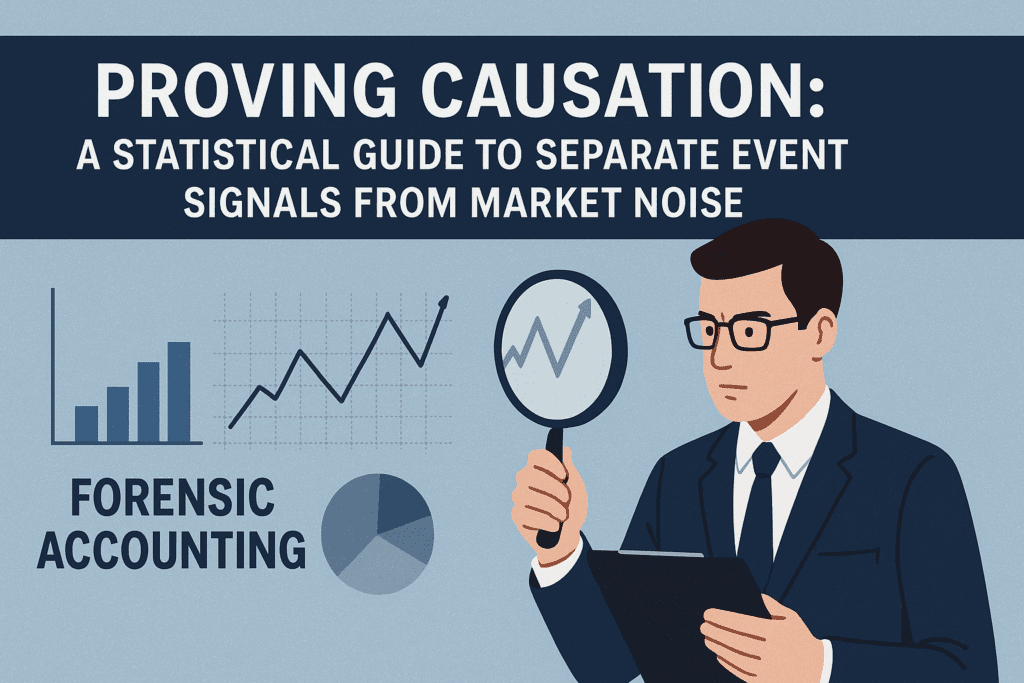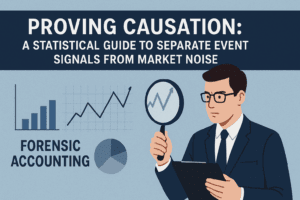Distinguishing genuine event impacts from background market noise represents one of the most challenging aspects of proving causation: isolating event impact from macro trends. Financial markets operate as complex systems where countless variables interact simultaneously, making it exceptionally difficult to demonstrate that specific events directly caused particular outcomes.
For expert witness CPAs tasked with providing compelling testimony, this challenge becomes particularly significant. Forensic accounting professionals must employ sophisticated statistical methods that go beyond simple correlation analysis. Consequently, litigation support requires robust frameworks that can withstand scrutiny in high-stakes legal environments. Although traditional event study methodologies exist, they often suffer from serious limitations when applied to real-world financial data.
This guide explores advanced statistical approaches for definitively proving causation in volatile markets. Furthermore, it examines why conventional methods frequently fail, how imputation frameworks offer more reliable alternatives, and what testing procedures ensure your conclusions remain valid despite market noise. By understanding these techniques, you’ll develop the analytical foundation necessary to separate genuine event signals from background economic fluctuations.
Defining Causal Effects in Event-Driven Markets
Causal effects represent the fundamental relationship between actions and outcomes—a concept essential for accurately analyzing market events. Unlike everyday examples where causation seems obvious (like turning on a light switch), financial markets present considerably greater complexity when attempting to isolate true causal relationships.
Potential Outcomes Framework for Market Events
The potential outcomes framework provides a rigorous foundation for causal inference in market settings. This approach conceptualizes causality as a comparison between two distinct states of the world: what happened versus what would have happened without the event. For each market participant or security, we consider both its observed outcome and its counterfactual outcome—the path not taken. Essentially, this framework defines the causal effect (τ) as the difference between these potential outcomes: τ = Y(1) – Y(0), where Y(1) represents the outcome with treatment and Y(0) without .[1]
In financial time series, however, we face what statisticians call “the fundamental problem of causal inference”—we can observe only one state of the world at any given time. Accordingly, the counterfactual outcome remains forever unobservable, requiring sophisticated estimation techniques rather than direct measurement .[2]
Treatment vs. Control in Financial Time Series
Establishing appropriate treatment and control groups forms the backbone of causal analysis in financial markets. The treatment group comprises entities exposed to the event being studied, while the control group consists of comparable entities not exposed to that same event .[3]
In contrast to randomized controlled trials in medicine or social sciences, financial markets rarely allow for random assignment. Moreover, time series data in finance presents unique challenges including nonstationarity, nonlinearity, and both contemporaneous and lagged effects . For this reason, forensic accounting professionals must carefully construct control groups that match the treatment group on key characteristics while differing only in exposure to the event.[4]
One viable approach involves comparing the change in outcomes over time between treatment and control groups—a method known as difference-in-differences analysis . This technique helps isolate the impact of specific events from broader market movements.[5]
Why Correlation Fails in Market Settings
Despite its widespread use, correlation analysis suffers from several critical limitations when attempting to prove causation:
- Direction of Influence: Correlation cannot determine which variable influences the other or whether both are influenced by an unseen third factor .[6]
- Nonlinearity: Correlation measures only linear relationships, potentially missing important nonlinear causal connections .[7]
- Confounding Variables: In financial markets, numerous variables simultaneously affect outcomes, creating misleading correlations .[8]
- Small Sample Effects: Market anomalies can create unreliable correlation coefficients, especially with limited data points .[8]
At its core, correlation simply identifies variables that change together—it cannot establish the “why” or “how” behind these relationships . For expert witness testimony and litigation support to withstand scrutiny, analysis must move beyond correlation to establish true causation.[1]
Challenges with Traditional Event Study Estimators
Traditional event study methods often face significant technical limitations that can undermine their reliability in legal and financial analysis contexts. These methodologies, while commonly used, contain structural problems that expert witness CPAs and forensic accountants must understand to provide accurate litigation support.
Negative Weighting in TWFE Models
Two-way fixed effects (TWFE) regression models frequently assign negative weights to treatment effects, creating potentially misleading results. In approximately 18% of TWFE papers published in economic journals from 2010-2012, multiple treatment variables were included . These multi-treatment TWFE models exhibit a troubling pattern: the coefficient for each treatment actually identifies two components. First, a weighted sum of that treatment’s effects (with weights summing to one but potentially negative), and second, a contamination term containing effects from other treatments .[9][9]
This contamination phenomenon occurs because these models leverage what researchers call “forbidden comparisons” – inappropriate difference-in-differences calculations comparing groups receiving multiple treatments simultaneously . Notably, TWFE models with several treatments typically contain more negative weights with larger absolute values than single-treatment models, making them even less robust to heterogeneous effects .[9][9]
Under-identification in Fully Dynamic Specifications
Fully dynamic event study specifications face fundamental identification challenges, particularly without a “never-treated” control group. In these models, researchers cannot differentiate between the effects of absolute time and relative time since treatment . This identification problem arises because there exists a perfect linear relationship between calendar year, event year, and relative time since event .[10][10]
This collinearity issue can cause statistical packages to drop arbitrary indicators, leading to unpredictable results . Without sufficient untreated observations, dynamic treatment effects and secular time trends become statistically indistinguishable .[11][12]
Spurious Long-Run Effects from Binned Lags
Traditional specifications often generate unreliable estimates of long-run causal effects through inappropriate extrapolation. When event studies bind multiple lags together (a common practice), they impose strong restrictions on treatment effect homogeneity . These restrictions can generate estimates for periods where no actual comparisons are possible.[11]
For instance, in datasets where both early and late-treated units exist but no never-treated control group is available, estimates of long-run effects may be entirely driven by unwarranted extrapolation rather than valid comparisons . Such extrapolation is particularly problematic since the upper limit for reliably estimating dynamic coefficients is bounded by the gap between earliest and latest treatment times observed .[11][11]
Robust Estimation Using Imputation Frameworks
Imputation frameworks offer a methodologically sound alternative to traditional event study approaches, specifically addressing the weaknesses of conventional estimators. Instead of relying solely on observed outcomes, these methods directly model counterfactual scenarios—what would have happened without the event.
Imputation of Untreated Potential Outcomes
At its core, imputation methodology reconstructs missing counterfactual outcomes through a transparent two-stage process. Initially, researchers estimate unit and period fixed effects using only untreated observations . Subsequently, these parameters are applied to predict what treated observations would have shown absent the intervention. This approach follows the logic that “all methods for causal inference can be viewed as imputation methods” , yet makes this connection explicitly operational.[11][11]
For expert witness CPAs, this transparent structure provides defensible analysis in litigation settings. The untreated potential outcome is formally defined as Y_it(0) = α_i + δ_t + ε_it, where α_i represents unit-specific parameters and δ_t captures time effects .[13]
Weighted Aggregation of τ_it Estimates
Once untreated potential outcomes are imputed, individual treatment effects τ_it can be estimated for each treated observation as the difference between observed outcome and imputed counterfactual . The final estimand emerges through weighted aggregation of these unit-level estimates.[14]
Forensic accounting professionals benefit from this framework’s flexibility in customizing weights based on specific litigation questions. The efficient estimator takes the intuitive form: first estimate fixed effects using untreated observations only; then impute counterfactuals; finally aggregate with appropriate weights .[15]
Conditions for Unbiased Estimation under Heterogeneity
Critically, imputation methods remain unbiased even with treatment effect heterogeneity—unlike traditional approaches requiring strong homogeneity assumptions. Nevertheless, several conditions must be satisfied. First, the parallel trends assumption must hold conditionally . Additionally, proper estimation requires accurately modeling the systematic components of untreated outcomes .[13][13]
The computational efficiency of these methods represents another advantage, as they require only estimating simple TWFE models on untreated observations , providing forensic accountants with practical tools for isolating genuine event impacts from broader market trends.[11]
Inference and Testing in Noisy Market Environments
Statistical inference faces unique challenges within noisy market environments where proving causation requires distinguishing genuine event impacts from random fluctuations.
Asymptotic Normality with Clustered Errors
Robust statistical inference fundamentally depends on correctly specifying error structures in financial data. Clustering—accounting for error correlation within defined groups—becomes essential as markets typically exhibit interdependence among observations. Under certain regularity conditions, estimators with properly clustered standard errors demonstrate asymptotic normality . Nonetheless, traditional large-cluster asymptotic approximations often perform poorly when cluster counts are limited . This creates particular difficulties for expert witness CPAs analyzing event impacts across limited market segments or geographical regions.[16][17]
Conservative Standard Errors via Auxiliary Models
When uncertainty about correlation structures exists, forensic accountants can employ conservative standard error estimation. This approach yields valid inference even under worst-case correlation scenarios . Such methods construct confidence intervals using only the variances of individual empirical moments without requiring knowledge of their correlation structure . Hence, these confidence intervals remain valid regardless of the underlying correlation pattern, though they may be wider than necessary for specific correlation structures.[18][18]
Testing Parallel Trends with Untreated Observations
Pre-trends tests—checking whether treatment and control groups followed parallel paths before intervention—often suffer from low power . Therefore, failing to reject parallel trends shouldn’t be interpreted as confirming their existence . Markedly better alternatives exist, including formalized restrictions on trend differences between pre-treatment and post-treatment periods . These methods explicitly account for both statistical uncertainty and identification uncertainty .[19][20][21][19]
Conclusion
Proving causation amidst market volatility remains a fundamental challenge for forensic accounting professionals. Statistical methodologies that effectively separate event signals from background noise stand as essential tools for expert witness CPAs presenting compelling testimony. Throughout this guide, we have explored why traditional approaches often fall short when analyzing complex financial data.
Correlation analysis, despite its widespread use, fails to establish true causal relationships in market settings due to issues with directionality, nonlinearity, and confounding variables. Similarly, conventional event study estimators suffer from significant limitations including negative weighting problems in TWFE models, under-identification in dynamic specifications, and spurious long-run effects from binned lags.
Alternatively, imputation frameworks offer a robust solution for causation analysis. These methods directly model counterfactual scenarios through a transparent two-stage process, thereby addressing the weaknesses inherent in traditional approaches. The ability to estimate individual treatment effects and aggregate them with appropriate weights provides forensic accountants with flexible, defensible analytical tools for litigation contexts.
Proper inference and testing procedures also play a crucial role when working with noisy market data. Conservative standard error estimation yields valid inference even under worst-case correlation scenarios, while improved testing of parallel trends helps distinguish genuine event impacts from random fluctuations.
After all, the ultimate goal remains consistent—developing analytical frameworks that withstand scrutiny in high-stakes legal environments. By understanding these advanced statistical techniques, forensic accounting professionals can definitively demonstrate causation, effectively isolating specific event impacts from broader market movements. This statistical foundation allows expert witnesses to present clear, convincing evidence that genuinely separates signal from noise in complex financial disputes.




